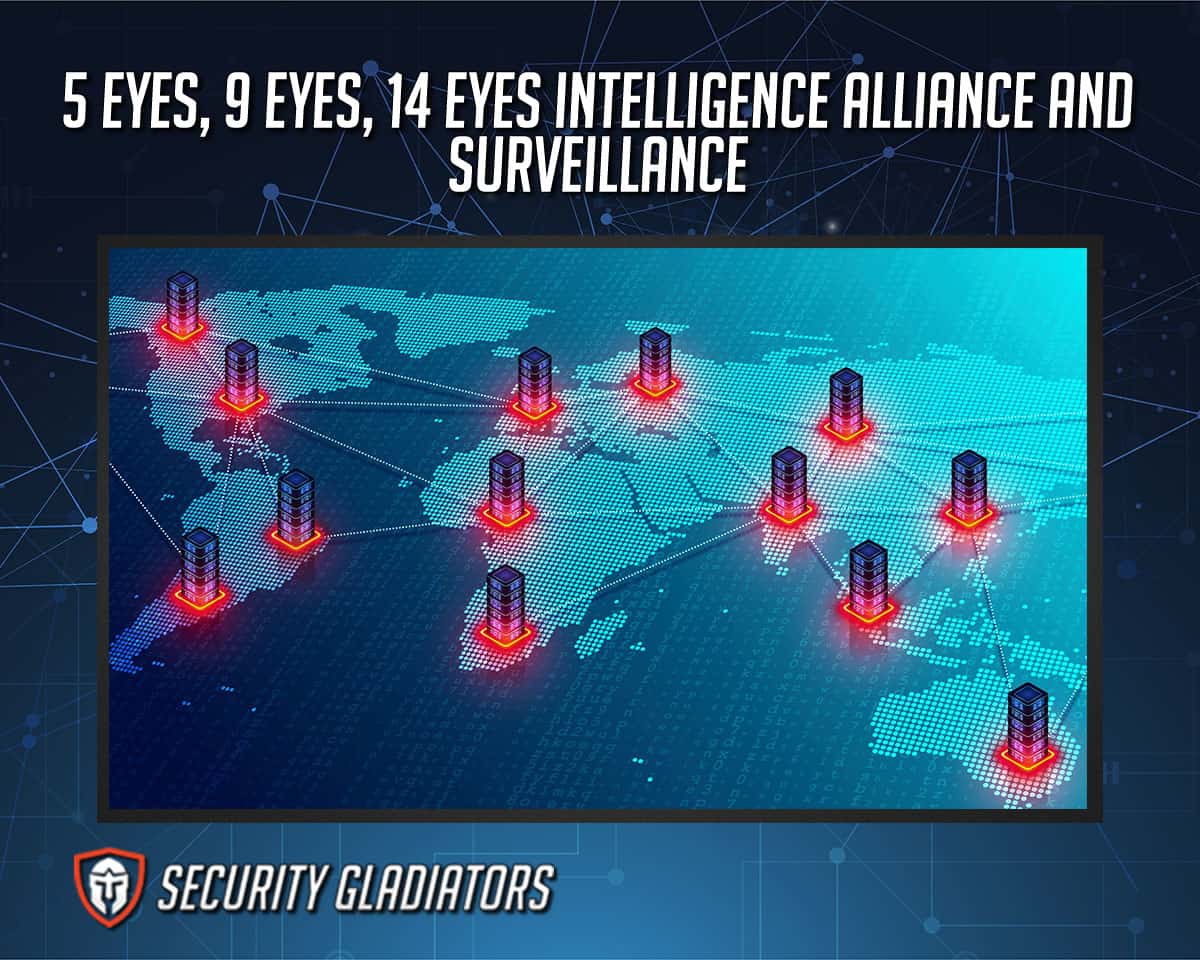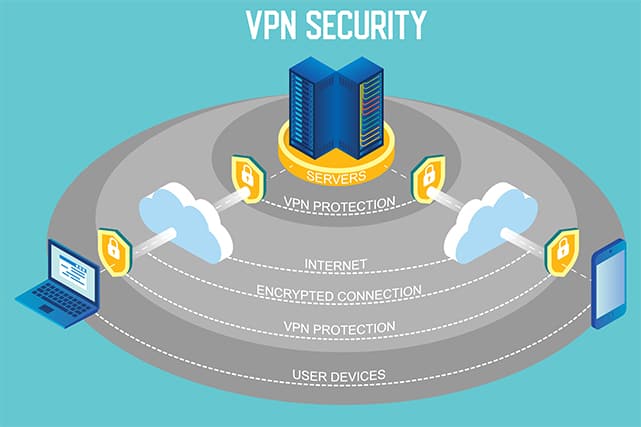These groups constitute global coalitions of nations engaged in international surveillance. These coalitions cooperate in gathering intelligence data from mass monitoring, which they then share. Since the UK-USA agreement and the Five Eyes sharing of intelligence, these networks have been conducting surveillance on people for decades, using policies that go back to World War II.
The government agencies behind these operations frequently collaborate with internet service providers and other significant technology corporations to gain access to crucial infrastructure to collect private data (data surveillance). This makes your ISP, for instance, an adversarial local organization that is collecting individual information on behalf of government agencies.

Table of Contents
What is the 5 Eyes Intelligence Alliance?
The Five Eyes is a group of countries that work together to share intelligence. Code-breakers from the United States and the United Kingdom held casual meetings during World War II, and from those discussions, the Five Eyes was born.
Secret discussions between British and American intelligence officials began in 1941, and by August of that year, the Atlantic Charter had been signed, outlining the countries’ post-war global goals. The Government Communications Headquarters in the United Kingdom (GCHQ) claims that the 1946 agreement between the United Kingdom and the United States was made possible by this Charter.
U.S. intelligence archives show that Canada, New Zealand, and Australia joined the Five Eyes alliance in 1948 and 1956, respectively, due to their Commonwealth ties. In 2020, the Five Eyes nations enlisted India and Japan to join them in a plea to tech companies to allow “backdoor access” to encrypted smartphone applications.

The FVEY conducted numerous notable missions after WWII, some of which are detailed below.
- British GCHQ (Government Communications Headquarters) and the United States National Security Agency (NSA) exchanged information gleaned from monitoring the military and diplomatic communications of the Soviet Union and its Eastern Bloc allies, including China.
- Agents from Australia and New Zealand supported the United States by keeping an eye on North Vietnamese air defense networks throughout the Vietnam War.
- Immediately following the conclusion of the Gulf War, the Australian Secret Intelligence Service (ASIS) dispatched a technician to bug the Kuwaiti government’s headquarters.
Which Countries are Part of The 5 Eyes Alliance?
The five nations that constitute the Five Eyes intelligence alliance are:
- The United States of America
- United Kingdom
- Canada
- Australia
- New Zealand
The idea originated with the UKUSA Agreement, which was signed by the countries mentioned above at the outset of the Cold War with the express purpose of sharing signals intelligence.
Which Agencies Are Involved in The 5 Eyes?
The following agencies (by country) are involved in the five eyes:
| Country | Agency | Abbreviation | Role |
|---|---|---|---|
| Australia | Australian Secret Intelligence Service | ASIS | Human intelligence |
| Australia | Australian Signals Directorate | ASD | Signal intelligence |
| Australia | Australian Security Intelligence Organization | ASIO | Security intelligence |
| Australia | Australian Geospatial-Intelligence Organization | AGO | Geo Intelligence |
| Australia | Defense Intelligence Organization | DIO | Defense Intelligence |
| Canada | Canadian Forces Intelligence Command | CFINTCOM | Defense, Geo, and Human Intelligence |
| Canada | Communications Security Establishment | CSE | Signal Intelligence |
| Canada | Canadian Security Intelligence Service | CSIS | Human intelligence, Security intelligence |
| Canada | Royal Canadian Mounted Police | RCMP | Security intelligence |
| New Zealand | Directorate of Defense Intelligence and Security | DDIS | Defense Intelligence |
| New Zealand | Government Communications Security Bureau | GCSB | Signal intelligence |
| New Zealand | New Zealand Security Intelligence Service | NZSIS | Human and Security intelligence |
| United Kingdom | Defense Intelligence | DI | Defense Intelligence |
| United Kingdom | Government Communications Headquarters | GCHQ | Signal intelligence |
| United Kingdom | Security Service | MI5 | Security intelligence |
| United Kingdom | Secret Intelligence Service | MI6, SIS | Human intelligence |
| United States | Central Intelligence Agency | CIA | Human intelligence |
| United States | Defense Intelligence Agency | DIA | Defense Intelligence |
| United States | Federal Bureau of Investigation | FBI | Security intelligence |
| United States | National Geospatial-Intelligence Agency | NGA | Geo Intelligence |
| United States | National Security Agency | NSA | Signal intelligence |
5 Eyes Intelligence Alliance History
An alliance of bilateral surveillance and intelligence-sharing agreements was established in 1946 by five English-speaking countries and their intelligence services, including the U.S. (NSA), the U.K. (GCHQ), Canada(CSEC), New Zealand(GCSB), and Australia(ASD). The Five Eyes alliance’s documents, known as the UKUSA agreement or the UK-US Communication Intelligence Act, are extensive, complex, and highly classified.

Following these arrangements, all Five Eyes states engage in intelligence-gathering activities like intercepting communications, collecting data, analyzing it, and decrypting it, and then automatically sharing the results with one another. In the decade that followed, Canada, Denmark, Norway, West Germany, New Zealand, and Australia joined them; nevertheless, only Canada, Australia, and New Zealand are included in the Five Eyes definition.
During the Cold War, the Five Eyes countries collaborated to collect and disseminate information about the Soviet Union. This collaboration resulted in the ECHELON surveillance system, which is responsible for keeping tabs on international phone calls, faxes, emails, and other electronic communications. In 2001, the Five Eyes shifted their attention to the Middle East and the War on Terror; more recently, they have also turned their attention to China. However, intelligence-gathering operations conducted by all members are worldwide in scope and not limited to the primary places of interest. There have been several charges of “industrial espionage,” and the public and lawmakers grew unhappy as monitoring programs became less focused on key targets and domestic populations.
What Information Do The 5 Eyes Collect and Share?
The Five Eyes program intercepts phone calls, text messages, fax, browsing history, metadata, IP addresses, instant messages, and emails from telephone networks, satellites, and fiber optic connections. The five eyes group also receives user information records from Microsoft, YouTube, Yahoo, Facebook, Google, AOL, Apple, Pal chat, and Skype. Each member nation allocates a few security agencies to specific duties. These roles include defense, human intelligence, security, signal intelligence, and geo-intelligence.
What Methods do the 5 Eyes Use to Collect Data?
When it comes to gathering intelligence, all SIGINT services use intermediaries like phone and internet providers to acquire sensitive customer information. Thanks to fiber-optic splitters installed at ISP nodes, the SIGINT agency can create a near-identical replica of the information being processed at any given time. After that, the data is analyzed using a technique called deep packet inspection and stored at various data centers. Spyware has also been linked to these alliances, it is installed on smartphones to monitor and track targets.
The Five Eyes Alliance monitors people in other member countries, and their own, by listening in on their phone calls and sifting through their messages using signals intelligence (SIGINT). By maintaining tabs on their respective citizens, the five eyes are able to circumvent domestic surveillance regulations. Since its start, the Five Eyes program has made steady progress. It has developed into a global, multinational initiative that can track information on entire populations.
What is the 9 Eyes Intelligence Alliance?
The Nine Eyes organization is an expansion of the Five Eyes alliance, and both groups work together similarly to gather information via mass surveillance and share it.

The following countries are part of the nine eyes intelligence alliance:
- Australia
- Canada
- New Zealand
- United Kingdom
- United States
- Denmark
- France
- The Netherlands
- Norway
Note:
These other four countries share the same capabilities as the Five Eyes but are not privy to all of the intelligence compiled by the Five Eyes. Additionally, Nine Eyes nations may share their data with the NSA or GCHQ.What is the 14 Eyes Intelligence Alliance?
The alliance known as “Fourteen Eyes” comprises 14 distinct nations, all of whom have consented to exchange their intelligence with one another. It all started in 1943 when the United States and the United Kingdom agreed on a ten-page Communication Intelligence pact.
Only five countries participated when it was initially started, and it was known as the BRUSA pact. Following that, the number of countries participating in the program increased to 9, which now encompasses 14 countries. In addition to these 14 countries, the network also receives support from several other countries that are not formal members but do provide consistent contributions.
The following countries are part of the 14 eyes intelligence alliance:
- Australia
- Canada
- New Zealand
- United Kingdom
- United States
- Denmark
- Netherlands
- France
- Norway
- Germany
- Belgium
- Spain
- Sweden
- Italy
The fourteen eyes alliance is problematic because it facilitates government spying on its populace by using other countries as proxies. For instance, the United States intelligence agencies might not be able to spy lawfully on their residents. However, they could ask another member’s intelligence service to spy on United States citizens on their behalf and provide them with the information they gather.
The U.S. government would then reciprocate for that member country. However, there is not a lot that can be done about it because it is an entirely different country that is not subject to U.S. jurisdiction.
What are the Dangers of the 5 Eyes, 9 Eyes, 14 Eyes Pact?
Privacy
5/9/14 Eyes is a global surveillance partnership with far-reaching privacy consequences. Edward Snowden’s revelations and other media articles show that your online activities, phone calls, and other sensitive information are fair game.
Five Eyes nations, including New Zealand, are linked to a U.S. military contractor’s attempt to obtain Pegasus Detection Tool. The New York Times recently reported that U.S. defense contractor L3Harris had talked to Israeli business NSO Group about buying spyware, despite NSO Group being barred by the U.S. Government. Five Eyes countries do more to harm privacy than share communications data. The 2001 USA PATRIOT Act authorized unprecedented surveillance of U.S. citizens. But wide-scale surveillance is not exclusively a U.S. phenomenon. U.K. and Australia also require ISPs to store user data.
Lack of Oversight
Oversight involves reviewing and monitoring public sector organizations’ policies, plans, programs, and projects to ensure they achieve intended objectives, provide excellent value for money, and comply with applicable policies, laws, regulations, and ethical standards. But when it comes to the five-eyes, nine-eyes, and 14-eyes pacts, it becomes a question of who watches the watchers. The lack of oversight of these operations is widespread and commonplace now.
Overreach
Another danger of the pact is that member countries can overreach and extend beyond the initial purpose; of sharing secrets. The public was made aware of this by Snowden’s media release where it was pointed out that the NSA had moved from spying on specific targets to spying on everyone.
How Can You Protect Yourself from the Dangers of Surveillance?

While there are numerous methods for concealing an individual’s internet activity, one tool, in particular, can assist in combating inappropriate surveillance by the Five Eyes Alliance: a virtual private network (VPN). Virtual private networks (VPNs) are permitted in all Five Eyes nations. A VPN hides internet activity by routing it through encrypted servers instead of ISP-owned ones. It would be complete gibberish to anyone who tried to decode your traffic.
Please remember that private surfing tabs, such as Incognito mode, will NOT conceal any browser activity from an ISP. It simply ensures that the activity is not kept in the device’s history. Use encrypted emails and encryption apps to safeguard passwords. Encrypting all email messages ensures that no one else may read their contents. Additionally, individuals can utilize privacy-focused browsers like Tor browser and encrypted messaging services to shield themselves from mass surveillance. Finally, stay off social media or use anonymous emails when registering an account, and never share any personal information on a social media account.

